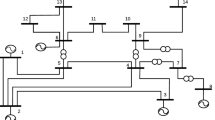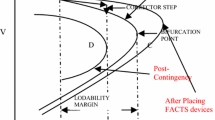Abstract
A novel algorithm for fast computation of the nearest operating point, where the power flow equations collapse was developed, based on singular value decomposition (SVD). It is claimed to be fast and capable to predict the loading direction to approach the maximum loading point of electric power systems, which requires introduction of minim power. This algorithm still needs to be verified against other established algorithms from the literature. This paper compares the SVD based algorithm against two other ones: (i) direct approach based on the second order Newton method and (ii) reference algorithm based on Monte-Carlo method. Several test systems are used as benchmark. The results confirm the robustness of the SVD based algorithm and its possibility for practical application.
Access this chapter
Tax calculation will be finalised at checkout
Purchases are for personal use only
Similar content being viewed by others
References
Nikolaev, N.: An algorithm for fast determining the point of collapse of power flow equations based on singular value decomposition. In: XV-th International Conference on Electrical Machines, Drives and Power Systems ELMA2017, 1–3 June 2017
Nikolaev, N.: A Monte Carlo algorithm for determining the point of collapse of power flow equations. In: XV-th International Conference on Electrical Machines, Drives and Power Systems ELMA2017, 1–3 June 2017
Chusovitin, P., Pazderin, A., Shabalin, G., Tashchilin, V., Bannykh, P.: Voltage stability analysis using Newton method. In: PowerTech, 2015 IEEE Eindhoven, 29 June–2 July 2015
Shabalin, G., Pazderin, A., Bannykh, P., Balakh, E.: Voltage stability analysis using quadratic objective function taking into account equality constraints. In: IEEE International Conference on the Science of Electrical Engineering (ICSEE), 16–18 November 2016
Torelli, F., Vaccaro, A.: A second order dynamic power flow model. Electr. Power Syst. Res. 126, 12–20 (2015)
Acknowledgements
This paper is a results from project “Study of the electric power system stability and frequency control at a predominant share of renewable energy generation” grant ДН07/27/15.12.2016 from the Bulgarian National Science Fund.
Author information
Authors and Affiliations
Corresponding author
Editor information
Editors and Affiliations
Rights and permissions
Copyright information
© 2018 Springer International Publishing AG
About this paper
Cite this paper
Nikolaev, N. (2018). Verification of SVD Based Algorithm for Voltage Stability Assessment Against Other Methods. In: Abraham, A., Kovalev, S., Tarassov, V., Snasel, V., Vasileva, M., Sukhanov, A. (eds) Proceedings of the Second International Scientific Conference “Intelligent Information Technologies for Industry” (IITI’17). IITI 2017. Advances in Intelligent Systems and Computing, vol 680. Springer, Cham. https://doi.org/10.1007/978-3-319-68324-9_33
Download citation
DOI: https://doi.org/10.1007/978-3-319-68324-9_33
Published:
Publisher Name: Springer, Cham
Print ISBN: 978-3-319-68323-2
Online ISBN: 978-3-319-68324-9
eBook Packages: EngineeringEngineering (R0)




